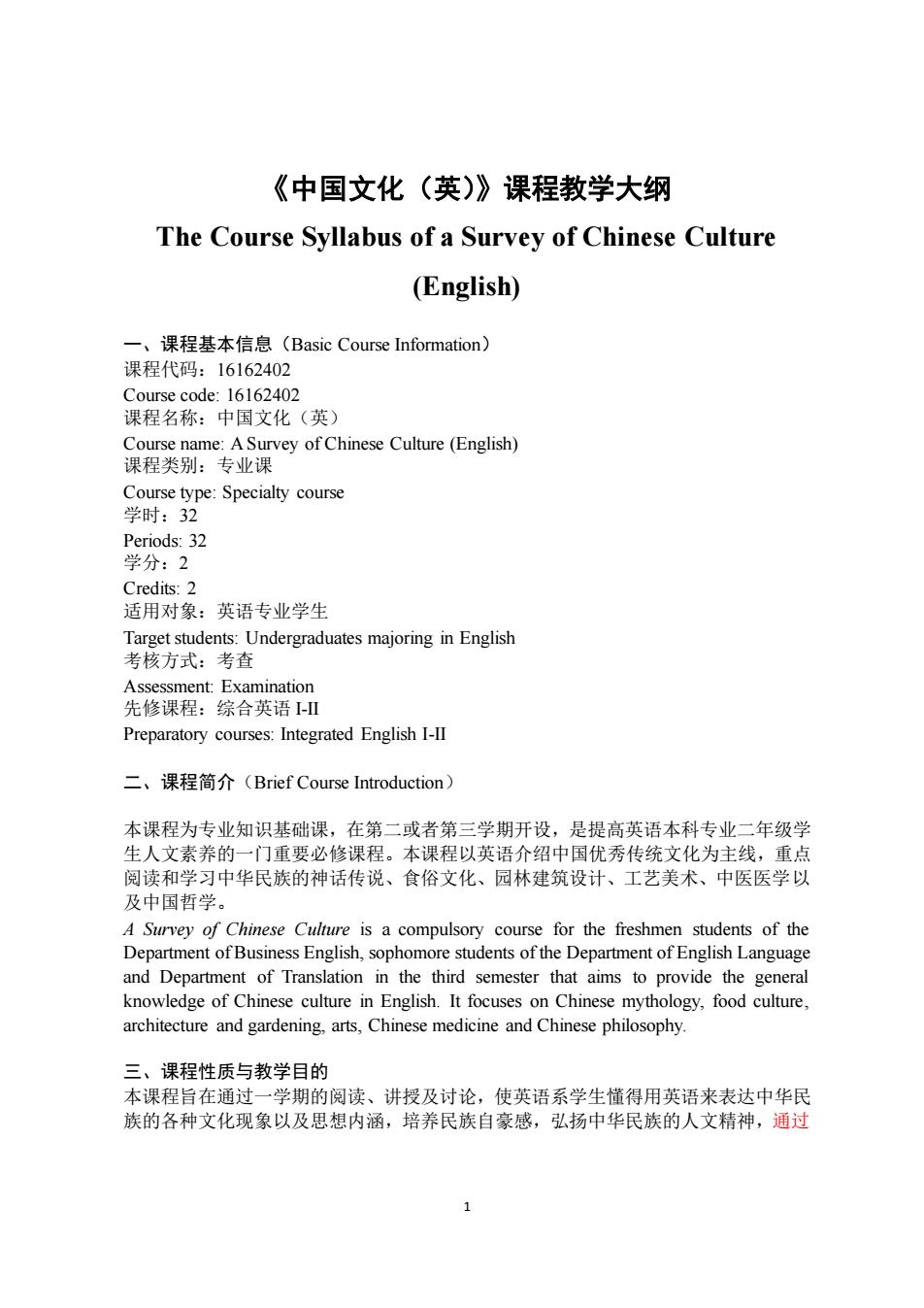
《中国文化(英)》课程教学大纲 The Course Syllabus of a Survey of Chinese Culture (English) 一、课程基本信息(Basic Course Information) 课程代码:16162402 Course name:ASurvey of Chinese Culture(English) 课程类别:专业课 Periods:32 学分:2 Credits:2 适用对象:英语专业学生 tudents:Undergraduates majoring in English Assessment:Examinatior 先修课程:综合英语Ⅱ Preparatory courses:Integrated English I-II 二、课程简介(Brief Course Introduction) 本课程为专业知识基础课,在第二或者第三学期开设,是提高英语本科专业二年级学 生人文素养的一门重要必修课程。本课程以英语介绍中国优秀传统文化为主线,重点 阅读和学习中华民族的神话传说、食俗文化、园林建筑设计、工艺美术、中医医学以 及中国哲学。 A Survey of Chinese Culture is a compulsory course for the freshmen students of the Department of Business English.sophomore students of the Department of English Language and Department of Translation in the third semester that aims to provide the general knowledge of Chinese culture in English.It focuses on Chinese mythology,food culture, architecture and gardening.arts,Chi emedicine and Chinese philo ophy 三、课程性质与教学目的 本课程旨在通过一学期的阅读、讲授及讨论,使英语系学生懂得用英语来表达中华民 族的各种文化现象以及思想内涵,培养民族自豪感,弘扬中华民族的人文精神,通过
1 《中国文化(英)》课程教学大纲 The Course Syllabus of a Survey of Chinese Culture (English) 一、课程基本信息(Basic Course Information) 课程代码:16162402 Course code: 16162402 课程名称:中国文化(英) Course name: A Survey of Chinese Culture (English) 课程类别:专业课 Course type: Specialty course 学时:32 Periods: 32 学分:2 Credits: 2 适用对象:英语专业学生 Target students: Undergraduates majoring in English 考核方式:考查 Assessment: Examination 先修课程:综合英语 I-II Preparatory courses: Integrated English I-II 二、课程简介(Brief Course Introduction) 本课程为专业知识基础课,在第二或者第三学期开设,是提高英语本科专业二年级学 生人文素养的一门重要必修课程。本课程以英语介绍中国优秀传统文化为主线,重点 阅读和学习中华民族的神话传说、食俗文化、园林建筑设计、工艺美术、中医医学以 及中国哲学。 A Survey of Chinese Culture is a compulsory course for the freshmen students of the Department of Business English, sophomore students of the Department of English Language and Department of Translation in the third semester that aims to provide the general knowledge of Chinese culture in English. It focuses on Chinese mythology, food culture, architecture and gardening, arts, Chinese medicine and Chinese philosophy. 三、课程性质与教学目的 本课程旨在通过一学期的阅读、讲授及讨论,使英语系学生懂得用英语来表达中华民 族的各种文化现象以及思想内涵,培养民族自豪感,弘扬中华民族的人文精神,通过

对中国哲学和价值观的分析和解读,培养学生的民族自豪感和爱国精神 进 一步培养 学生树立正确的社会主义价值观:通过习近平治国理政学习平台主要关注和学习中西 文化的内涵差异及英文表达的适切性、也注意引导学生关注中国传统文化,培养文化 敏成性,树立多元文化的观念 四、教学内容与要求 Unit One Chinese Mythology (一)目的与要求 1.To know and be able to tell about the historical figures in Chinese mythology ith the historical development of Chi ese mytho To understand the common themes and features of Chinese mythology 4.To learn about some differences and similarities ofthe Chinese creation story and the biblical story 5.To leam useful words and expressions that relate to Chinese mythology and improve English language skill (二)教学内容 Chinese Mythology 1.Introduction (1)The definitior of mythology (2)The classic of Mountains and Seas (3)Three religious traditions 2.Roots of Chinese mythology nasty onfucianism and Taoism (3)Buddhism 3.Common themes in Chinese Mythology (1)The creation of the world out of chaos. (2)The importance of nature (3)The re ence for estors 4.Features of Chinese Mythology (1)They sing the praises of labour and creation (2)Thev extol perseverance and self-sacrifice (3)They praise rebellion against oppression. (4)They eulogize the year ng for true love (5)They encourage good de eds and d warn against sin Jingwei determines to fill up the seas;Yugong moved the mountains To emphasize how diligent Yugong is and how determined he is,reflecting Chinese people's perseverance and self-sacrifice
2 对中国哲学和价值观的分析和解读,培养学生的民族自豪感和爱国精神,进一步培养 学生树立正确的社会主义价值观;通过习近平治国理政学习平台主要关注和学习中西 文化的内涵差异及英文表达的适切性、也注意引导学生关注中国传统文化,培养文化 敏感性,树立多元文化的观念。 四、教学内容与要求 Unit One Chinese Mythology (一)目的与要求 1. To know and be able to tell about the historical figures in Chinese mythology 2. To be familiar with the historical development of Chinese mythology 3. To understand the common themes and features of Chinese mythology 4. To learn about some differences and similarities of the Chinese creation story and the biblical story 5. To learn useful words and expressions that relate to Chinese mythology and improve English language skills (二)教学内容 I. Chinese Mythology 1. Introduction (1) The definition of mythology (2) The classic of Mountains and Seas (3) Three religious traditions 2. Roots of Chinese mythology (1) From the Xia to Zhou Dynasty (2) Confucianism and Taoism (3) Buddhism 3. Common themes in Chinese Mythology (1) The creation of the world out of chaos. (2) The importance of nature (3) The reverence for ancestors 4. Features of Chinese Mythology (1) They sing the praises of labour and creation (2) They extol perseverance and self-sacrifice. (3) They praise rebellion against oppression. (4) They eulogize the yearning for true love. (5) They encourage good deeds and warn against sin. II. Jingwei determines to fill up the seas; Yugong moved the mountains To emphasize how diligent Yugong is and how determined he is, reflecting Chinese people’s perseverance and self-sacrifice
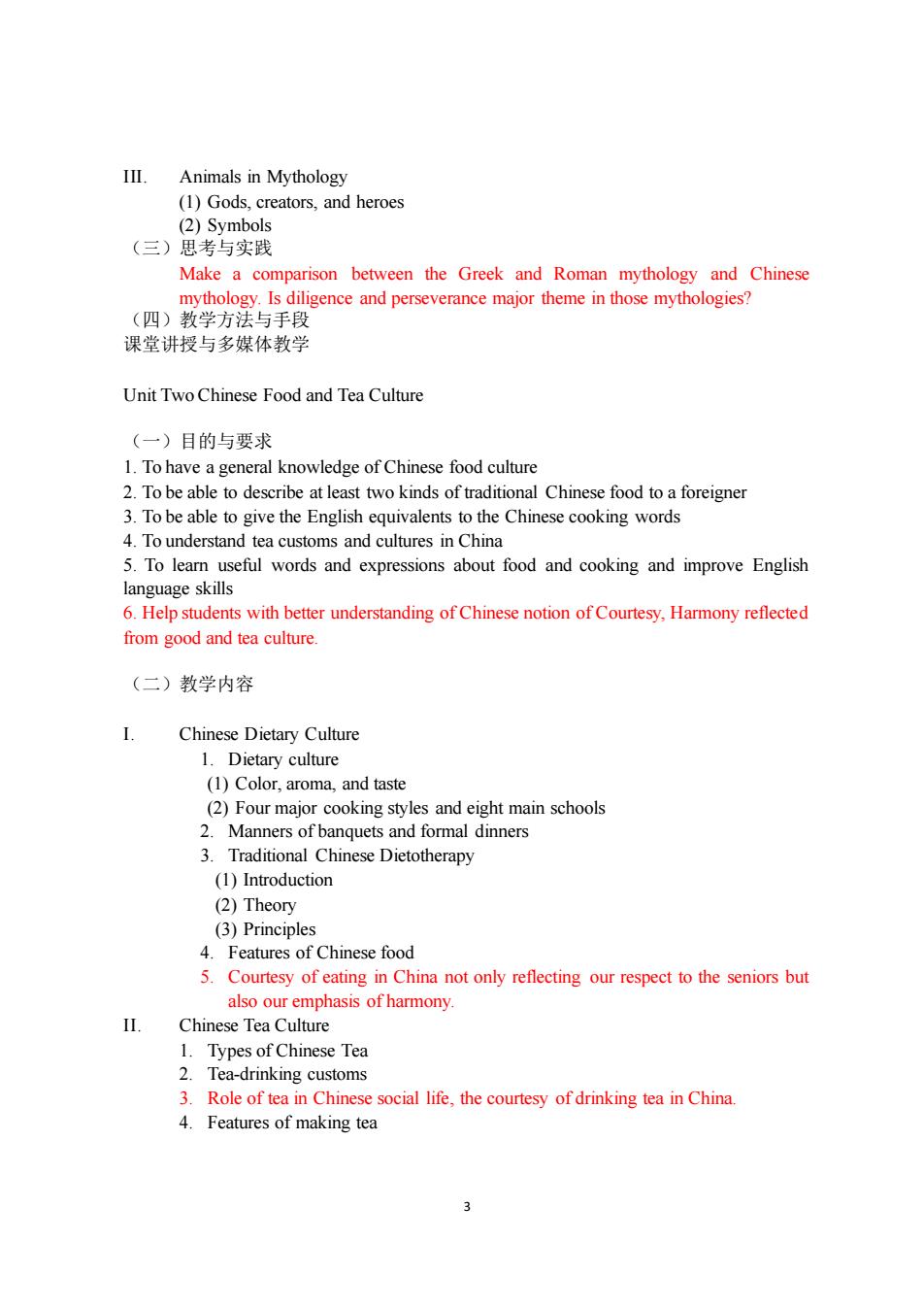
11. Animals in Mythology (1)Gods.creators.and heroes (2)Svmbols (三)思考与实践 Make a comparison between the Greek and Roman mythology and Chinese mythology.Is diligence and perseverance major theme in those mythologies? (四)教学方法与手段 课堂讲授与多媒体教学 Unit Two Chinese Food and Tea Culture (一)目的与要求 1.To have a general knowledge of Chinese food culture 2.To be able to describe at least two kinds of traditional Chinese food to a foreigner 3.To be able to give the English equivalents to the Chinese cooking words 4.To understand tea customs and cultures in China 5.To learn useful words and expressions about food and cooking and improve english language skills 6 Help students with better understanding of Chinese notion of Courtesy.Harmony reflected from good and tea cultur (二)教学内容 Chinese Dietary Culture 1.Dietary c culture (1)Color,aroma,and taste (2)Four major cooking styles and eight main schools 2.Manners of banquets and formal dinners 3.Traditional Chinese Dietotherapy (1)Introduction (2)Theory (3)Principles 4.Features of Chinese food 5.Courtesy of eating in China not only reflecting our respect to the seniors but also our emphasis of harmony. Chinese Tea Culture 1.Types of Chinese Tea 2.Tea-drinking customs 3.Role of tea in Chinese social life,the courtesy of drinking tea in China. 4.Features of making tea
3 III. Animals in Mythology (1) Gods, creators, and heroes (2) Symbols (三)思考与实践 Make a comparison between the Greek and Roman mythology and Chinese mythology. Is diligence and perseverance major theme in those mythologies? (四)教学方法与手段 课堂讲授与多媒体教学 Unit Two Chinese Food and Tea Culture (一)目的与要求 1. To have a general knowledge of Chinese food culture 2. To be able to describe at least two kinds of traditional Chinese food to a foreigner 3. To be able to give the English equivalents to the Chinese cooking words 4. To understand tea customs and cultures in China 5. To learn useful words and expressions about food and cooking and improve English language skills 6. Help students with better understanding of Chinese notion of Courtesy, Harmony reflected from good and tea culture. (二)教学内容 I. Chinese Dietary Culture 1. Dietary culture (1) Color, aroma, and taste (2) Four major cooking styles and eight main schools 2. Manners of banquets and formal dinners 3. Traditional Chinese Dietotherapy (1) Introduction (2) Theory (3) Principles 4. Features of Chinese food 5. Courtesy of eating in China not only reflecting our respect to the seniors but also our emphasis of harmony. II. Chinese Tea Culture 1. Types of Chinese Tea 2. Tea-drinking customs 3. Role of tea in Chinese social life, the courtesy of drinking tea in China. 4. Features of making tea
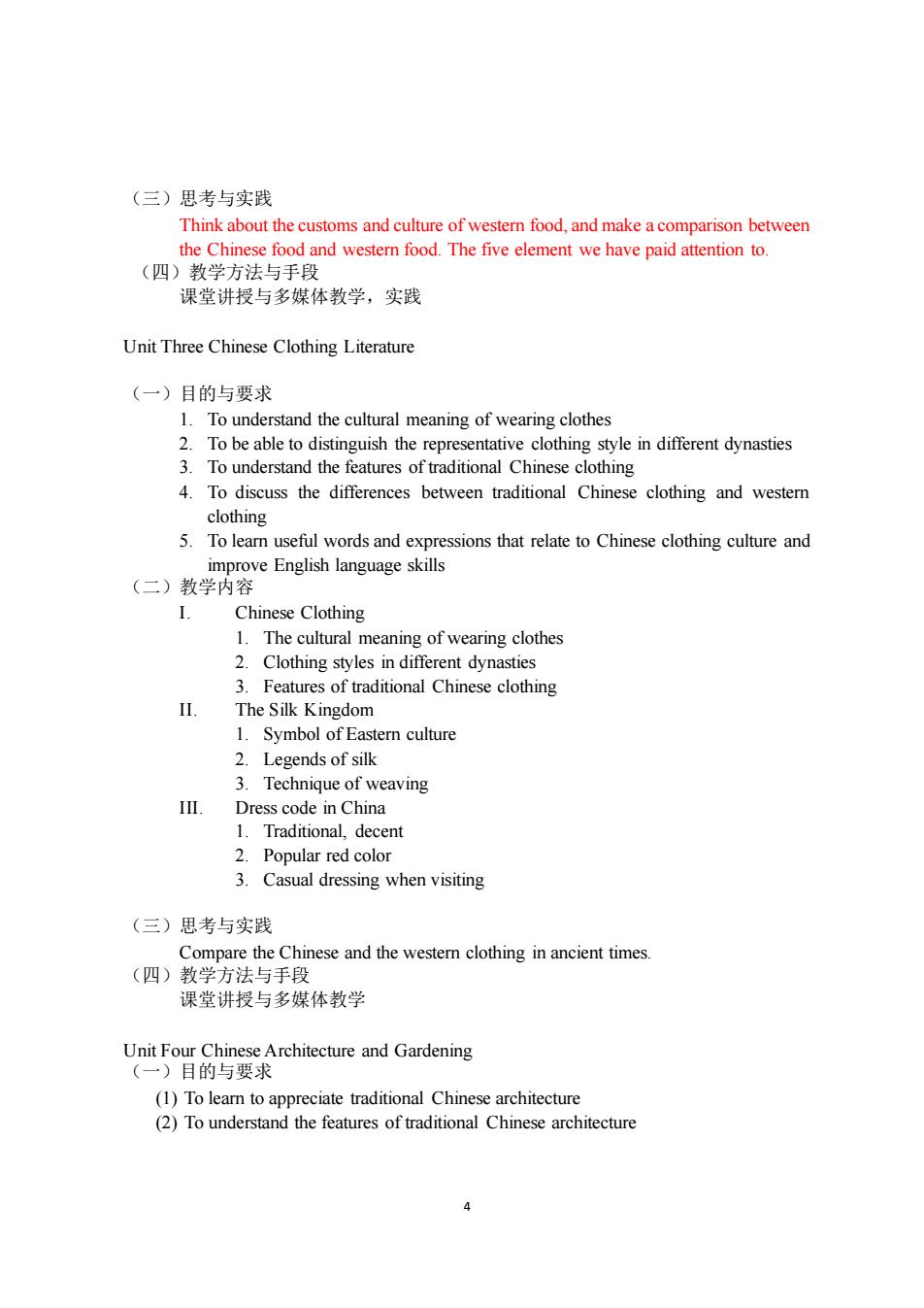
(三)思考与实践 Think about the customs and culture of western food,and make a comparison between the Chin e food and westem food.The five element we have paid attention to (四)教学方法与手段 课堂讲授与多媒体教学,实践 Unit Three Chinese Clothing Literature (一)目的与要求 To understand the cultural meaning of wearing clothes 2.To be able to distinguish the representative clothing style in different dynasties 3.To understand the features of traditional Chinese clothing 4.To discuss the differences between traditional Chinese clothing and western 5.To leam useful words and expressions that relate to Chinese and (一)教学闲容engangge Chinese Clothing 1.The cultural meaning of wearing clothes 2 Clothing styles in different dynasties Features of traditional Chinese clothing I The Silk Kingdom 1.Symbol of Eastern culture 2.Legends of silk Technique weaving Dress code in China 1.Traditional,decent 2.Popular red color 3.Casual dressing when visiting (三)思考与实践 Compare the Chinese and the western clothing in ancient times (四)教学方法与手段 课堂讲授与多媒体教学 Architecture and Gardening (1)To learn to appreciate traditional Chinese architecture (2)To understand the features oftraditional Chinese architecture 4
4 (三)思考与实践 Think about the customs and culture of western food, and make a comparison between the Chinese food and western food. The five element we have paid attention to. (四)教学方法与手段 课堂讲授与多媒体教学,实践 Unit Three Chinese Clothing Literature (一)目的与要求 1. To understand the cultural meaning of wearing clothes 2. To be able to distinguish the representative clothing style in different dynasties 3. To understand the features of traditional Chinese clothing 4. To discuss the differences between traditional Chinese clothing and western clothing 5. To learn useful words and expressions that relate to Chinese clothing culture and improve English language skills (二)教学内容 I. Chinese Clothing 1. The cultural meaning of wearing clothes 2. Clothing styles in different dynasties 3. Features of traditional Chinese clothing II. The Silk Kingdom 1. Symbol of Eastern culture 2. Legends of silk 3. Technique of weaving III. Dress code in China 1. Traditional, decent 2. Popular red color 3. Casual dressing when visiting (三)思考与实践 Compare the Chinese and the western clothing in ancient times. (四)教学方法与手段 课堂讲授与多媒体教学 Unit Four Chinese Architecture and Gardening (一)目的与要求 (1) To learn to appreciate traditional Chinese architecture (2) To understand the features of traditional Chinese architecture

(3)To know the differences between traditional Chinese architecture and Western architecture (4)To lean useful words and expressions about architecture and gardening and improve (二)教学内容 anguage skills 1. Text A Ancient Chinese Architecture 1.Characteristics of Ancient Architectural Styles (1)emphasis on the horizontal (2)principle of balance and symmetry (3)making houses face south (4)timber framework (5)feng shui (6)symbolic roof 2.Imperial Architecture (1)palace (2)mausoleum (3)altars and ancestral temples 3.Religious Architecture (1Localization of Chinese Buddhist architecture (2)Pagoda (3)Grotto complex 4.Graceful Garden Architecture mperial gar rdens (2)Private gardens in the Souh 5.Traditional Culture Manifested in Ancient Chinese Architecture (1)Embodying the traditional ethical ideas (2)Idea of"unity of Heaven and man' (4)Emboc and blending of traditional culture with other cultures Number“g”and Stone lions 1.Number“g (1)Symbol of the supreme sovereignty of the emperor. (2)Combined with"s” 2. Chinese Stone Lions (1)representing power and prestige (2)indicating the ranks of officials (3)Buddhist symbol of nobleness and dignity (三)思考与实 Tell about the relationship between nature and traditional Chinese architecture.and 5
5 (3) To know the differences between traditional Chinese architecture and Western architecture (4) To lean useful words and expressions about architecture and gardening and improve English language skills (二)教学内容 I. Text A Ancient Chinese Architecture 1. Characteristics of Ancient Architectural Styles (1) emphasis on the horizontal (2) principle of balance and symmetry (3) making houses face south (4) timber framework (5) feng shui (6) symbolic roof 2. Imperial Architecture (1) palace (2) mausoleum (3) altars and ancestral temples 3. Religious Architecture (1) Localization of Chinese Buddhist architecture (2) Pagoda (3) Grotto complex 4. Graceful Garden Architecture (1) Imperial gardens (2) Private gardens in the South 5. Traditional Culture Manifested in Ancient Chinese Architecture (1) Embodying the traditional ethical ideas (2) Idea of “unity of Heaven and man” (3) Principle of integration of variety (4) Embodying communication and blending of traditional culture with other cultures. II. Number “9” and Stone lions 1. Number “9” (1) Symbol of the supreme sovereignty of the emperor. (2) Combined with “5” 2. Chinese Stone Lions (1) representing power and prestige (2) indicating the ranks of officials (3) Buddhist symbol of nobleness and dignity (三)思考与实践 Tell about the relationship between nature and traditional Chinese architecture, and
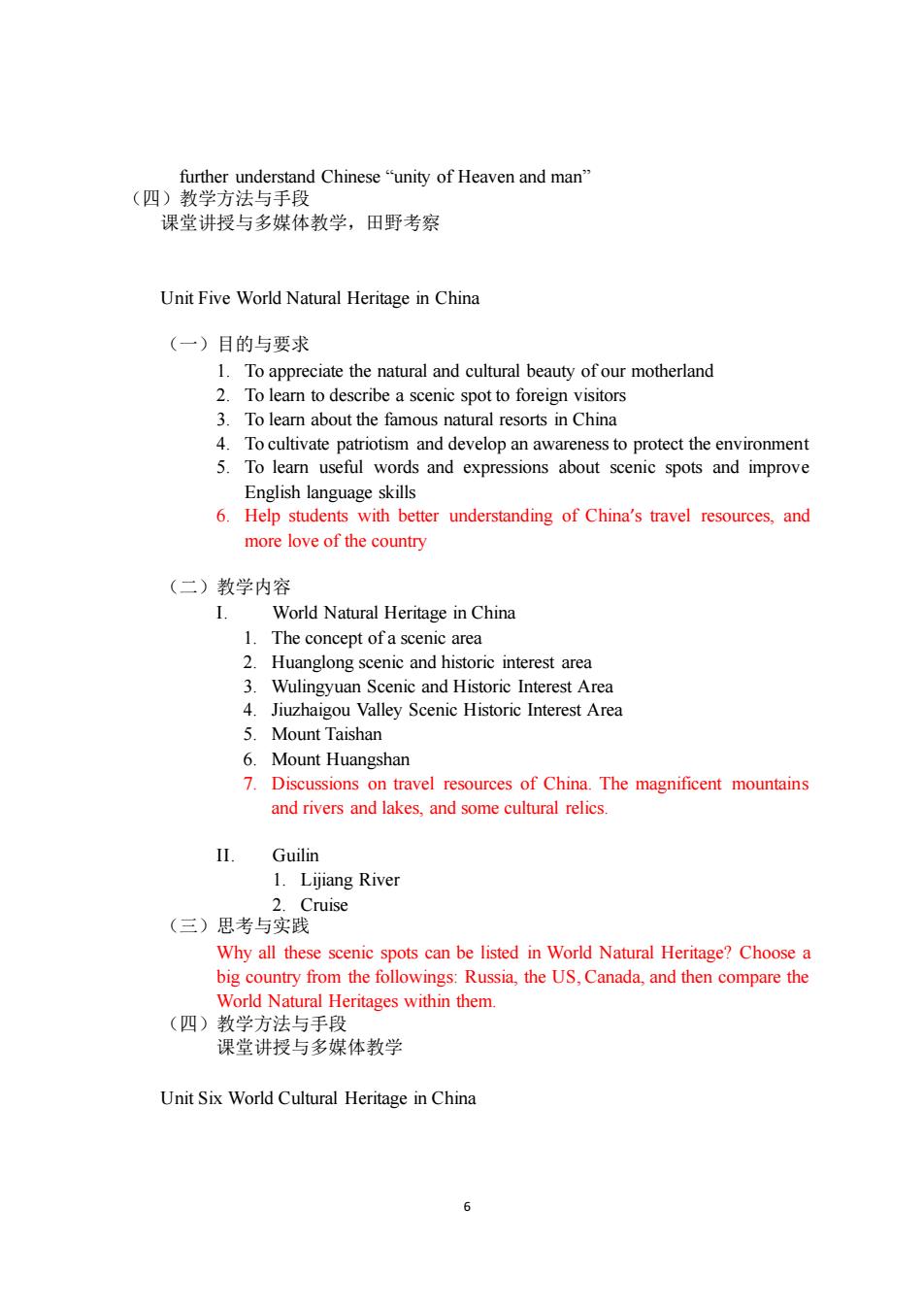
further understand Chinese"unity of Heaven and man" (四)教学方法与手段 课堂讲授与多媒体教学,田野考察 Unit Five World Natural Heritage in China (一)目的与要求 1.the natural and cra eauty of our otherland 2.To lam to describ a scenic spot to foreign visitors 3 To learn about the famous natural resorts in China 4.To cultivate patriotism and develop an awareness to protect the environment 5.To learn useful words and expressions about scenic spots and improve English language skills 6.Help students with better understanding of China's travel resources,and more love of the country (二)教学内容 World Natural Heritage in China 1.The concept ofa sce area 2. and historic interest area 3. Wulingyuan Scenic and Historic Interest Area 4. Jiuzhaigou Valley Scenic Historic Interest Area 5 Mount Taishan 6.Mount Huangshan 7.Discussions vel resources of China. The magnificent mountains and rivers and lakes,and some cultural relics. II.Guilin 1.Liiiang River (三)思考与头 Why all these scenic spots can be listed in World Natural Heritage?Choose a big country from the followings:Russia,the US.Canada,and then compare the World Natural Heritages within them. (四)教学方法与手段 课堂讲授与多媒体教学 Unit Six World Cultural Heritage in China
6 further understand Chinese “unity of Heaven and man” (四)教学方法与手段 课堂讲授与多媒体教学,田野考察 Unit Five World Natural Heritage in China (一)目的与要求 1. To appreciate the natural and cultural beauty of our motherland 2. To learn to describe a scenic spot to foreign visitors 3. To learn about the famous natural resorts in China 4. To cultivate patriotism and develop an awareness to protect the environment 5. To learn useful words and expressions about scenic spots and improve English language skills 6. Help students with better understanding of China’s travel resources, and more love of the country (二)教学内容 I. World Natural Heritage in China 1. The concept of a scenic area 2. Huanglong scenic and historic interest area 3. Wulingyuan Scenic and Historic Interest Area 4. Jiuzhaigou Valley Scenic Historic Interest Area 5. Mount Taishan 6. Mount Huangshan 7. Discussions on travel resources of China. The magnificent mountains and rivers and lakes, and some cultural relics. II. Guilin 1. Lijiang River 2. Cruise (三)思考与实践 Why all these scenic spots can be listed in World Natural Heritage? Choose a big country from the followings: Russia, the US, Canada, and then compare the World Natural Heritages within them. (四)教学方法与手段 课堂讲授与多媒体教学 Unit Six World Cultural Heritage in China
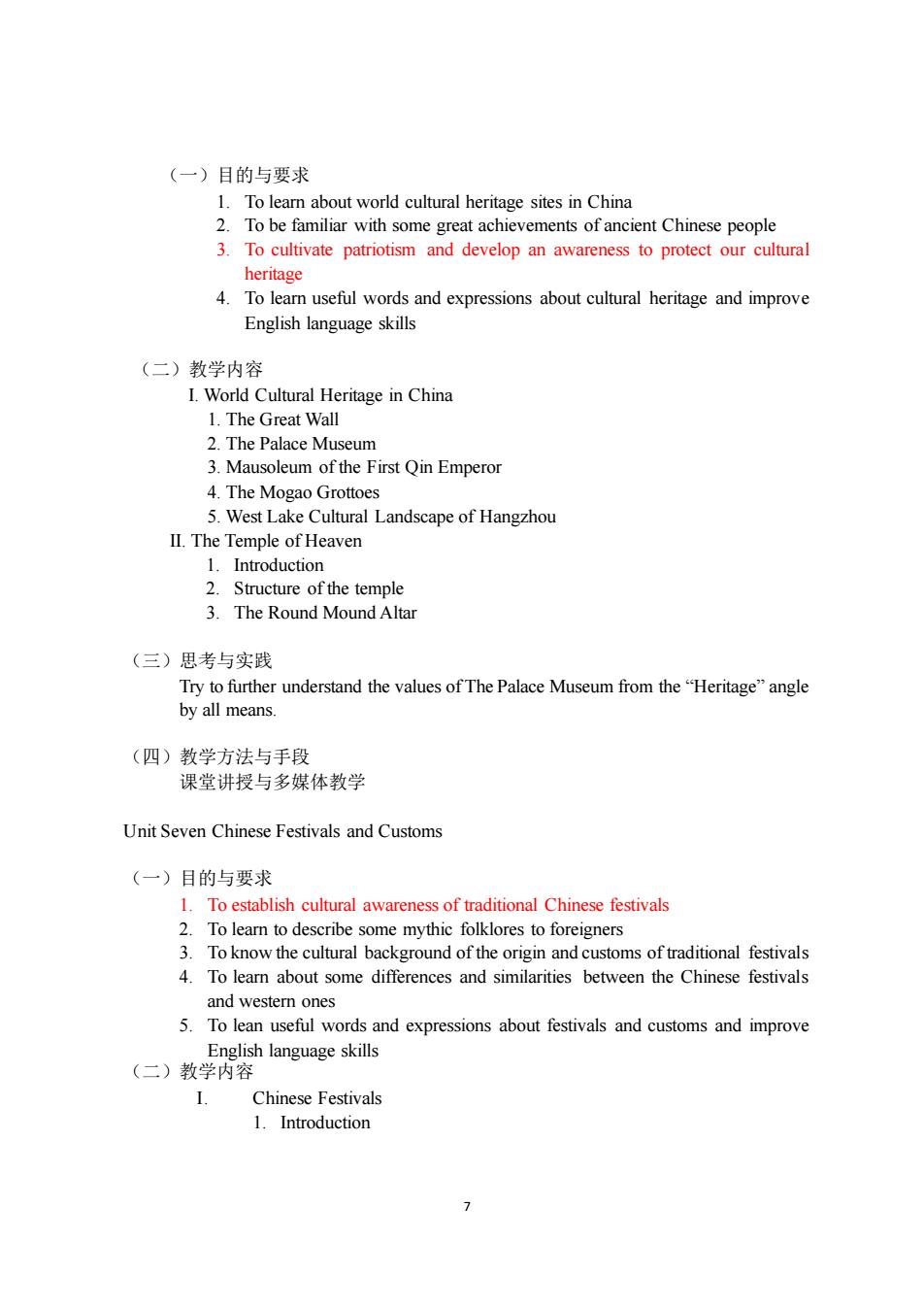
(一)目的与要求 1 To learn about world cultural heritage sites in china 2.To be familiar with some gre eat achie hents of ancient Chinese people 3.To cultivate patriotism and develop an awareness to protect our cultural heritage 4.To learn useful words and expressions about cultural heritage and improve English language skills (二)教学内容 World Cultural Heritage in China 1.The Great Wall 2.The Palace Museum 3.Mausoleum of the First Qin Emperor 4.The Mogao Grottoes 5.West Lake Cultural Landscape of Hangzhou II.The Temple of Heaven 1.Introduction 2.Structure of the temple 3 The round mound altar (三)思考与实践 Try to further understand the values of The Palace Museum from the"Heritage"angle by all means. (四)教学方法与手段 课堂讲授与多媒体教学 Unit Seven Chinese Festivals and Customs (一)目的与要求 Toestablish cultural awareness of traditional Chinese festivals 2.To learn to describe some mythic folklores to foreigners 3.To know the cultural background of the origin and customs of traditional festivals 4.To learn about some differences and similarities between the Chinese festivals and western ones 5.To lean useful words and expressions about festivals and customs and improve English language skills (二)教学内容 Chinese festivals 1.Introduction
7 (一)目的与要求 1. To learn about world cultural heritage sites in China 2. To be familiar with some great achievements of ancient Chinese people 3. To cultivate patriotism and develop an awareness to protect our cultural heritage 4. To learn useful words and expressions about cultural heritage and improve English language skills (二)教学内容 I. World Cultural Heritage in China 1. The Great Wall 2. The Palace Museum 3. Mausoleum of the First Qin Emperor 4. The Mogao Grottoes 5. West Lake Cultural Landscape of Hangzhou II. The Temple of Heaven 1. Introduction 2. Structure of the temple 3. The Round Mound Altar (三)思考与实践 Try to further understand the values of The Palace Museum from the “Heritage” angle by all means. (四)教学方法与手段 课堂讲授与多媒体教学 Unit Seven Chinese Festivals and Customs (一)目的与要求 1. To establish cultural awareness of traditional Chinese festivals 2. To learn to describe some mythic folklores to foreigners 3. To know the cultural background of the origin and customs of traditional festivals 4. To learn about some differences and similarities between the Chinese festivals and western ones 5. To lean useful words and expressions about festivals and customs and improve English language skills (二)教学内容 I. Chinese Festivals 1. Introduction

(1)Lunar calendar (2)Gregorian calendar 2.The Spring Festival 3.The Lantern Fes ival 4.The Qingming Festiva 5. The Dragon Boat Festiva 6.The Mid-Autumn Festival 7.The Double Ninth Festival Chinese Folklore The Chinese Zodiac Fengshui 3.Fortune-telling 4.Jade 5 Talismans 6.Palmistry 7.Face Reading (三)思考与实践 1.Tell about your hometown's customs. e00yfe人nVNn Autmn Festival,wll you talk about th romance between Chang'e and Houyi?Will you talk about nutritious awareness of ancient Chinese who took more fat and sweet food to prepare their body for the harsh winter? 3.What is the best way of promoting Chinese festivals? (四)教学方法与手段 课堂讲授与多媒体教学 Unit Eight Arts and Crafts (一)目的与要求 1.To leam the history and characteristics of some traditional arts and crafts 2.To learn the cultural connotations of some art forms 3.To cultivate an awareness of the urgency to preserve traditional arts and crafts 4.To learn useful words and expressions about arts and crafts and improve English language skills (二)教学内容 Chinese Arts and Crafts 1.Bronze Craft
8 (1) Lunar calendar (2) Gregorian calendar 2. The Spring Festival 3. The Lantern Festival 4. The Qingming Festival 5. The Dragon Boat Festival 6. The Mid-Autumn Festival 7. The Double Ninth Festival II. Chinese Folklore 1. The Chinese Zodiac 2. Fengshui 3. Fortune-telling 4. Jade 5. Talismans 6. Palmistry 7. Face Reading (三)思考与实践 1. Tell about your hometown’s customs. 2. Suppose you are going to share a box of mooncake with your foreign friends during the Mid-Autumn Festival, will you talk about the romance between Chang’e and Houyi? Will you talk about nutritious awareness of ancient Chinese who took more fat and sweet food to prepare their body for the harsh winter? 3. What is the best way of promoting Chinese festivals? (四)教学方法与手段 课堂讲授与多媒体教学 Unit Eight Arts and Crafts (一)目的与要求 1. To learn the history and characteristics of some traditional arts and crafts 2. To learn the cultural connotations of some art forms 3. To cultivate an awareness of the urgency to preserve traditional arts and crafts 4. To learn useful words and expressions about arts and crafts and improve English language skills (二)教学内容 I. Chinese Arts and Crafts 1. Bronze Craft
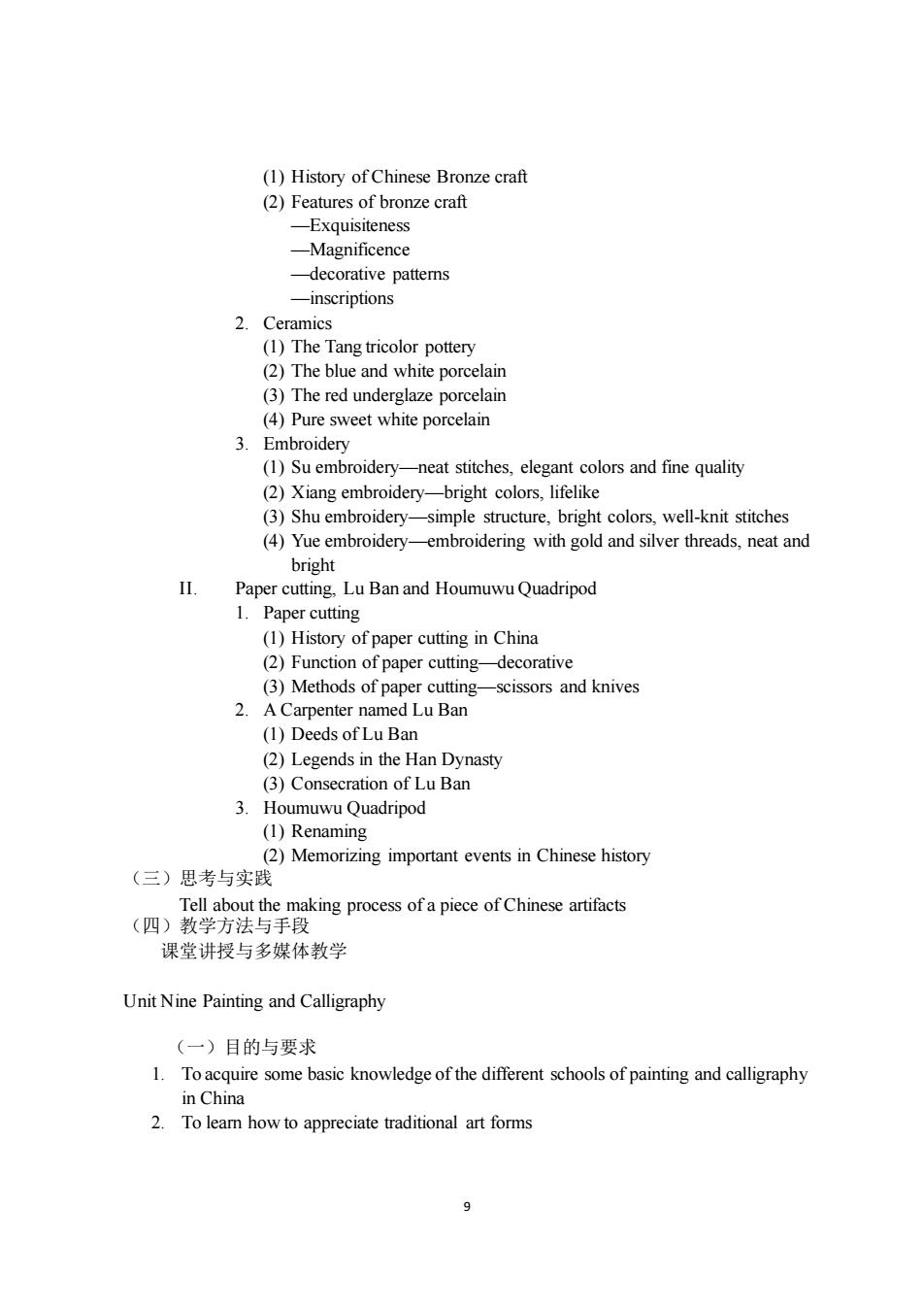
(1)History ofChinese Bronze craft (2)Features of bronze craft -Magnificenc decorative pattems -Inscriptions 2.Ceramics (1)The Tang tricolor pottery (The blue and hte porcelain (4)Pure sweet white porcelain 3.Embroidery (I))Su embroiderv. -neat stitches,elegant colors and fine quality (2)Xiang embroidery-bright colors,lifelike ()Shu embroidery-simple structure,bright colors,well-knit stitches (4)Yue embroidery-embroidering with gold and silver threads,neat and bright Paper cutting.Lu Ban and Houmuwu Quadripod 1.Paper cutting (1)History of paper cutting in Chin (2)Function of paper cutting-decorative (3)Methods of paper cutting- -scissors and knives 2.A Carpenter named Lu Ban (1)Deeds of Lu Ban ()Legends in the Han Dynasty (3)Consecration of I Lu Ban 3.Houmuwu Quadripod (1)Renaming (2)Memorizing important events in Chinese history (三)思考与实 proces of a piece of Chinese artifacts tt 方 课堂讲授与多媒体教学 Unit Nine Painting and Calligraphy (一)目的与要求 1.Toacquire some basic knowledge of the different schools of painting and calligraphy in China 2.To leam how to appreciate traditional art forms
9 (1) History of Chinese Bronze craft (2) Features of bronze craft —Exquisiteness —Magnificence —decorative patterns —inscriptions 2. Ceramics (1) The Tang tricolor pottery (2) The blue and white porcelain (3) The red underglaze porcelain (4) Pure sweet white porcelain 3. Embroidery (1) Su embroidery—neat stitches, elegant colors and fine quality (2) Xiang embroidery—bright colors, lifelike (3) Shu embroidery—simple structure, bright colors, well-knit stitches (4) Yue embroidery—embroidering with gold and silver threads, neat and bright II. Paper cutting, Lu Ban and Houmuwu Quadripod 1. Paper cutting (1) History of paper cutting in China (2) Function of paper cutting—decorative (3) Methods of paper cutting—scissors and knives 2. A Carpenter named Lu Ban (1) Deeds of Lu Ban (2) Legends in the Han Dynasty (3) Consecration of Lu Ban 3. Houmuwu Quadripod (1) Renaming (2) Memorizing important events in Chinese history (三)思考与实践 Tell about the making process of a piece of Chinese artifacts (四)教学方法与手段 课堂讲授与多媒体教学 Unit Nine Painting and Calligraphy (一)目的与要求 1. To acquire some basic knowledge of the different schools of painting and calligraphy in China 2. To learn how to appreciate traditional art forms
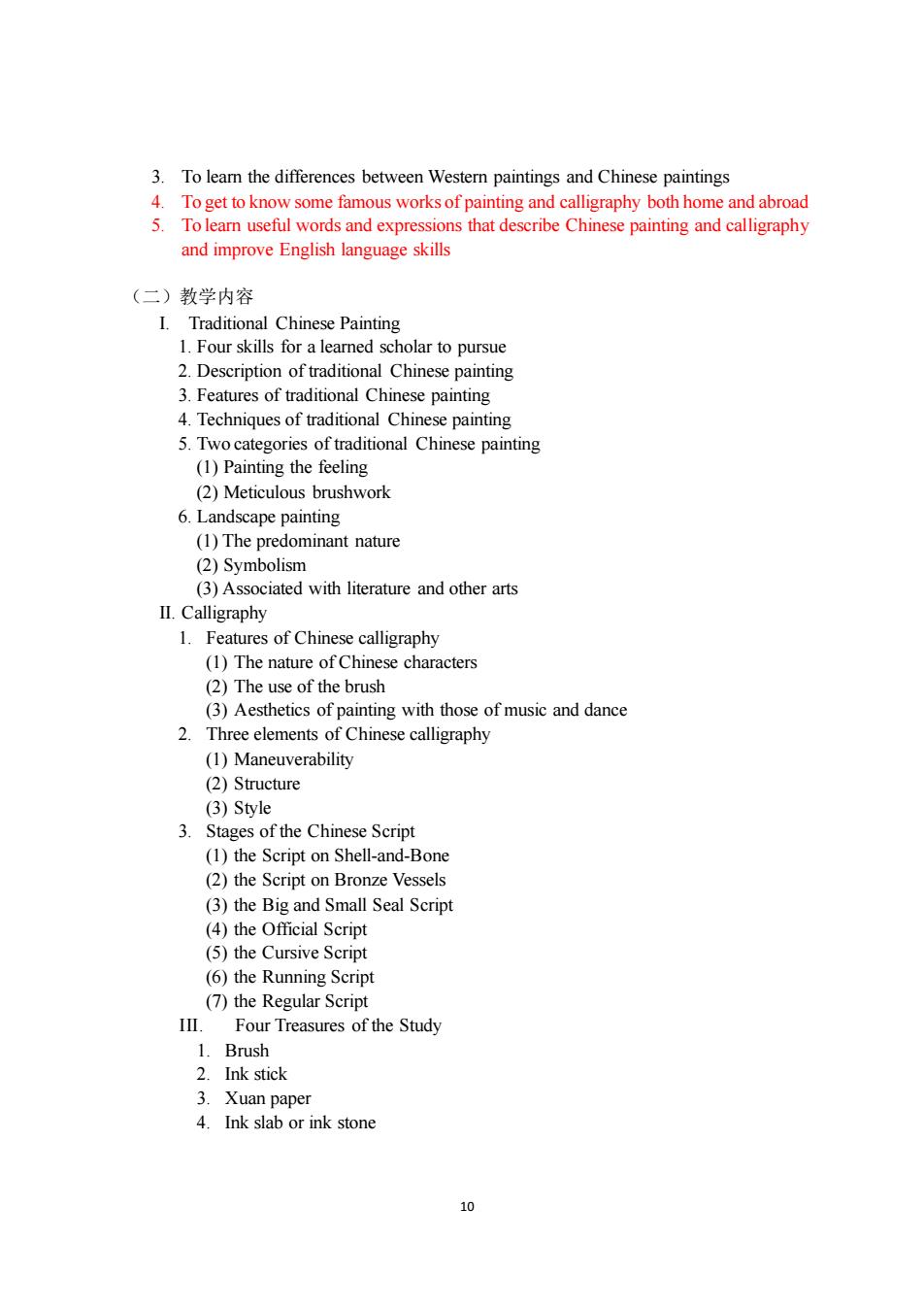
3.To leam the differences between Western paintings and Chinese paintings 4.To get to know some famous works of painting and calligraphy both home and abroad 5.To leam useful words and expressions that describe Chinese painting and calligraphy and mprove English language skills (二)教学内容 I.Traditional Chinese Painting 1.Four skills for a learned scholar to pursue 2.Description of traditional Chinese painting 3 Fe es of traditional Chi se painting Techniques of traditional Chinese painting 5.Two categories of traditional Chinese painting (1)Painting the feeling (2)Meticulous brushwork 6 andscape painting (1)The predominant nature (2)Symbolism (3)Associated with literature and other arts II.Calligraphy 1.Features of Chinese calligraphy (1)The nature ofChinese characters (2)The use of the brush (3)Aesthetics of painting with those of music and dance 2.Three elements of Chinese calligraphy (1)Maneuverability (2)Stn cture (3)Sty 3.Stages of the Chinese Script (1)the Script on Shell-and-Bone (2)the Script on Bronze Vessels and Small Seal Scrip Scrip (5)the Cursive Script (6)the running Script (7)the Regular Script Four Treasures of the Study Brush 2.Ink stick 3.Xuan paper 4.Ink slab or ink stone 10
10 3. To learn the differences between Western paintings and Chinese paintings 4. To get to know some famous works of painting and calligraphy both home and abroad 5. To learn useful words and expressions that describe Chinese painting and calligraphy and improve English language skills (二)教学内容 I. Traditional Chinese Painting 1. Four skills for a learned scholar to pursue 2. Description of traditional Chinese painting 3. Features of traditional Chinese painting 4. Techniques of traditional Chinese painting 5. Two categories of traditional Chinese painting (1) Painting the feeling (2) Meticulous brushwork 6. Landscape painting (1) The predominant nature (2) Symbolism (3) Associated with literature and other arts II. Calligraphy 1. Features of Chinese calligraphy (1) The nature of Chinese characters (2) The use of the brush (3) Aesthetics of painting with those of music and dance 2. Three elements of Chinese calligraphy (1) Maneuverability (2) Structure (3) Style 3. Stages of the Chinese Script (1) the Script on Shell-and-Bone (2) the Script on Bronze Vessels (3) the Big and Small Seal Script (4) the Official Script (5) the Cursive Script (6) the Running Script (7) the Regular Script III. Four Treasures of the Study 1. Brush 2. Ink stick 3. Xuan paper 4. Ink slab or ink stone